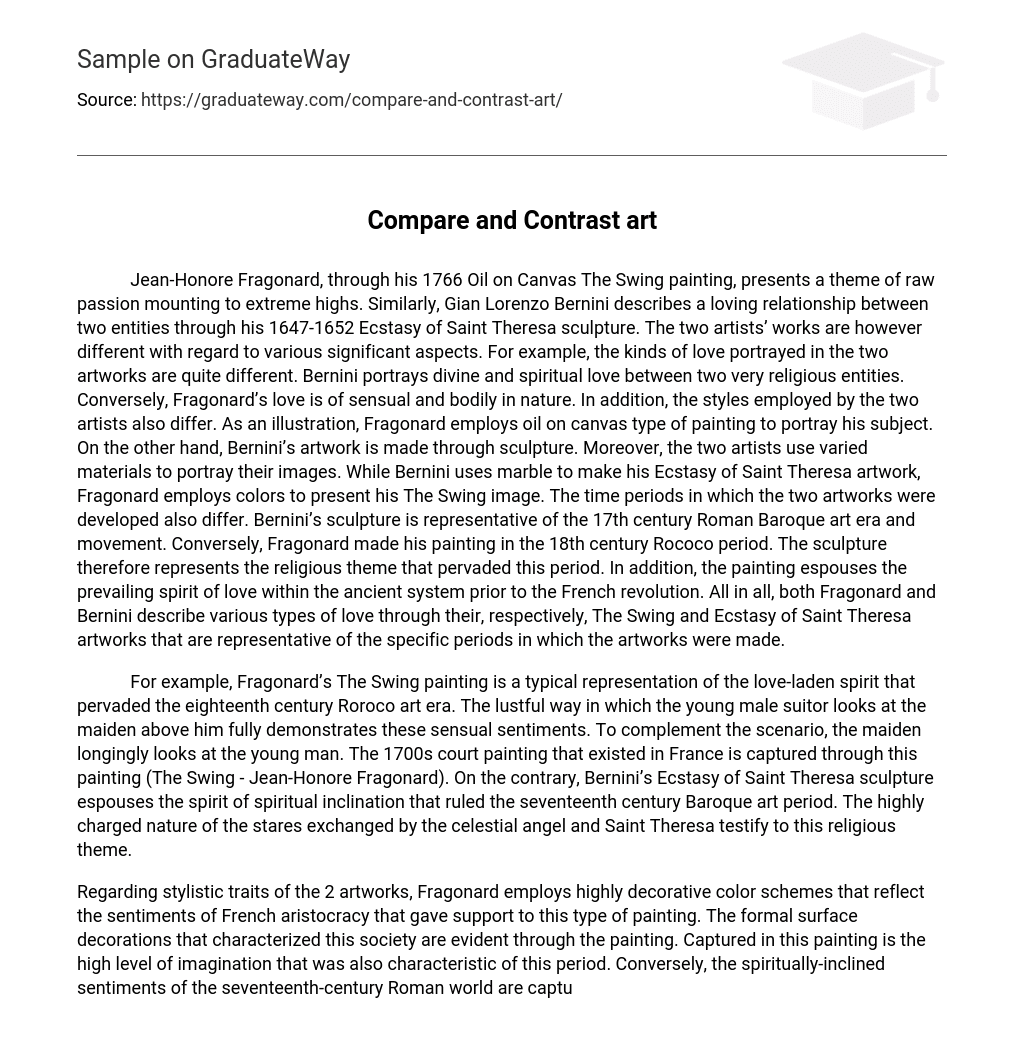Jean-Honore Fragonard presents a theme of raw passion that reaches extreme highs in his 1766 Oil on Canvas painting, The Swing. Similarly, Gian Lorenzo Bernini describes a loving relationship between two entities through his 1647-1652 sculpture, Ecstasy of Saint Theresa. However, the two artists’ works differ significantly in various aspects.
For example, the kinds of love portrayed in the two artworks are quite different. Bernini portrays divine and spiritual love between two very religious entities. Conversely, Fragonard’s love is sensual and bodily in nature.
The styles employed by the two artists also differ. Fragonard uses oil on canvas to portray his subject while Bernini’s artwork is made through sculpture. Moreover, they use varied materials to portray their images; Bernini uses marble for Ecstasy of Saint Theresa while Fragonard employs colors for The Swing.
The time periods in which the artworks were developed also differ; Bernini’s sculpture represents the 17th century Roman Baroque art era and movement while Fragonard made his painting during the 18th century Rococo period when love was highly valued before French revolution.
In conclusion, both Fragonard and Bernini describe various types of love through their respective artworks that are representative of specific periods when they were made.
For example, Fragonard’s painting The Swing” is a typical representation of the love-laden spirit that pervaded the eighteenth-century Rococo art era. The young male suitor’s lustful gaze towards the maiden above him fully demonstrates these sensual sentiments. To complement this scenario, the maiden longingly looks back at the young man. This painting captures the courtly culture of 1700s France (The Swing – Jean-Honore Fragonard).
In contrast, Bernini’s sculpture “Ecstasy of Saint Theresa” embodies the spiritual inclination that ruled over seventeenth-century Baroque art. The highly charged nature of the stares exchanged between celestial angel and Saint Theresa testify to this religious theme.
Regarding the stylistic traits of the two artworks, Fragonard employs highly decorative color schemes that reflect the sentiments of French aristocracy who supported this type of painting. The formal surface decorations that characterized this society are evident in the painting, capturing the high level of imagination that was also characteristic of this period.
Conversely, Fragonard’s Ecstasy of Saint Theresa sculpture captures the spiritually-inclined sentiments of seventeenth-century Roman world. The sculpture portrays a deep kind of affection between a divine and mortal entity, reflecting prevailing religious views that heaven could have beneficial communion with earthly humans. Saint Theresa is shown to be intimately connected to a divine angel who influences her moods.
Regarding the subject matter of the two artworks, The Ecstasy of Saint Theresa sculpture portrays an angel and Saint Theresa suspended in the air. The expressions on their faces illustrate deep affection, with Saint Theresa appearing to be smitten by the angel and surrendering completely to him. Their bodies are slightly displaced, with the angel aiming a golden arrow at Saint Theresa’s heart while she appears to be sinking on the clouds beneath her feet. The arrow is a central aspect of this sculpture.
In contrast, Fragonard’s The Swing depicts a young maiden enjoying herself on a swing pushed by an older clergyman behind her. A young man dressed smartly gazes at her with desire as she swings high enough for him to see her underwear due to her wide-parted legs. Her right shoe has flown off due to forward momentum and is above her head while luxuriant flower shrubs partially hide the young man holding his hat.
The two artworks consist of various symbolic elements that demonstrate the profound affection between Saint Theresa and the angel. In Fragonard’s Swing painting, the girl surrenders herself to the young man by allowing her shoe to fly off. The young man removing his hat shows respect for the maiden. The presence of a clergyman symbolizes religious backing for their relationship. The pink color of her dress represents purity, while dolphins in water near them symbolize love.
Bernini’s sculpture also has various symbolic elements. The arrow held by the angel has two connotations: firstly, it alludes to mythical cupid who can make any lady love him; secondly, it points towards Saint Theresa’s heart area and symbolizes their love-based bond with each other. Death figure below Saint Theresa represents bad times while their sparkly appearance signifies happiness and purity.
Regarding similarities, The Swing and the Ecstasy of Saint Theresa present a common theme of love. However, the two artworks differ in their specific subject matter. While the Ecstasy of Saint Theresa represents spiritual love, The Swing portrays earthly affection. This comparison is appropriate because it demonstrates the prevailing sentiments that existed when these artworks were created.
Fragonard’s painting, The Swing, exemplifies the courtly painting style that was popular in 18th century France. In contrast, Bernini’s sculpture, Ecstasy of Saint Theresa, reflects the religious views prevalent in 17th century Rome.
Works Cited
The Swing is a painting by Jean-Honoré Fragonard. It can be viewed at http://www.bc.edu/bc_org/avp/cas/his/CoreArt/art/anc_frag_swing.html and was created on May 18th, 2010.





